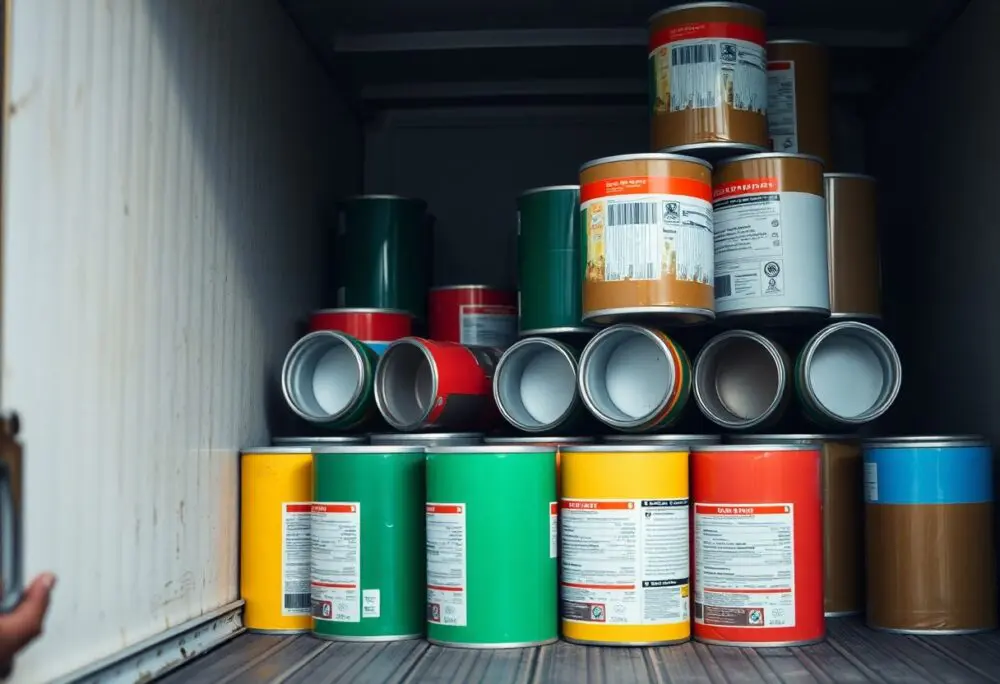Removal of empty paint cans can seem straightforward, but it’s important to understand the guidelines before discarding them. You may wonder if they pose any risks or if there are specific regulations regarding their disposal. Knowing how to handle empty paint cans properly ensures your junk removal process is safe and environmentally friendly. In this blog post, you’ll learn about the safety considerations and best practices for dealing with empty paint cans, helping you make informed decisions as you clear out your space.
Key Takeaways:
- Empty paint cans can be safely disposed of if they are completely dry and free of any residual paint.
- Local regulations may vary regarding the disposal of paint cans, so it’s important to check with local waste management services for specific guidelines.
- Recycling empty paint cans may be an option, but ensure they are made of recyclable materials like metal, and verify acceptance with your recycling center.
Understanding Empty Paint Cans
Before you consider disposing of empty paint cans, it’s crucial to understand their impact and safety. Many homeowners often underestimate the consequences of improper disposal, which can harm the environment and may violate local regulations. The contents, even when dried, can sometimes lead to misunderstandings about their safety level. It’s best to familiarize yourself with the composition and the potential residues left behind to make informed decisions regarding junk removal.
Composition of Paint Cans
After using a paint can, it’s helpful to know what it’s made of. Most paint cans are primarily composed of metal or plastic, designed to hold the chemical compositions of paints and solvents. The metal cans are typically made of aluminum or steel, which can be recycled, while plastic containers vary depending on the type of paint and its components.
Types of Paint and Their Residues
Below are different types of paints and their potential residues you should be aware of:
| Type of Paint | Residue Characteristics |
| Latex Paint | Water-based, relatively safe when fully dried |
| Oil-Based Paint | Contains solvents, can emit harmful fumes |
| Spray Paint | Aerosols can be flammable; requires careful handling |
| Enamel Paint | Durable finish but contains toxic solvents |
| Stains and Varnishes | Contains hazardous chemicals; must be disposed of properly |
Understanding the type of paint you use can guide your approach to disposal. Different paint residues can have specific implications for safety and environmental impact.
- Latex paints are safer and easier to dispose of once dried.
- Oil-based paints need careful handling to prevent environmental damage.
- Spray paints pose flammability risks and require special disposal methods.
- Enamel paints may contain harmful solvents that should not be poured down drains.
- Stains and varnishes often have hazardous chemicals needing careful consideration.
Knowing the type of paint and how to dispose of it properly helps ensure your safety and protects the environment.
Safety Concerns with Empty Paint Cans
It is important to understand that empty paint cans can still pose safety risks during junk removal. While they may seem harmless, residual paint fumes or chemicals can linger within the can, leading to potential health hazards. Therefore, before disposing of them, ensure they are completely empty and, if necessary, refer to resources like Empty paint can disposal : r/UtilityLocator for safe disposal methods.
Potential Hazards
Beside fumes, empty paint cans can also create sharp edges which pose physical injury risks during transportation. If the cans haven’t been fully dried or are crushed, they might leak remnants of hazardous substances that can be harmful to both you and the environment.
Local Regulations and Guidelines
Beside safety concerns, local regulations may dictate how you should handle and dispose of empty paint cans. It is important to check your municipality’s specific guidelines to ensure compliance, as improper disposal could result in fines or environmental hazards.
Due to varying local regulations, some areas may require you to take empty paint cans to specific recycling facilities or waste disposal sites, while others might allow curbside pickup. Make sure to check local waste management resources or governmental websites to gain insight into proper disposal practices within your area.
Junk Removal Options
Many people looking to declutter their space wonder about their junk removal options. Whether you’re tackling a home renovation or just cleaning out your garage, understanding the various ways to dispose of unwanted items can make the process smoother and more efficient. From hiring professionals to utilizing community services, there are several routes you can take to handle your junk responsibly.
Disposal Services
The right disposal service can simplify your junk removal efforts significantly. These services often provide convenient pick-up and transport of your items, ensuring that they are disposed of in compliance with local regulations. They can also save you time and effort, allowing you to focus on more important tasks.
Recycling Programs
Behind every responsible junk removal strategy, recycling programs play a significant role in minimizing waste. These initiatives focus on repurposing materials, reducing landfill contributions, and promoting sustainability. By choosing to participate in recycling programs, you can ensure that your items are handled in an eco-friendly manner.
To make the most of recycling programs, you should familiarize yourself with the specific rules and guidelines in your area. Different materials, such as metals, plastics, and paints, have unique recycling procedures. Many community programs and local recycling centers offer drop-off locations or collection events, making it easy for you to dispose of items responsibly. By prioritizing recycling, you contribute to a cleaner environment and help promote the efficient use of resources.
Preparing Empty Paint Cans for Disposal
Once again, you should take the necessary steps to ensure your empty paint cans are safe for disposal. It is important to prepare them properly to avoid any potential hazards during the junk removal process. By following these guidelines, you’ll not only comply with local regulations but also contribute to a safer environment. This preparation will make it easier for junk removal services to handle your disposed items responsibly.
Cleaning and Rinsing
Against common belief, simply tossing empty paint cans into your trash can lead to environmental hazards. Start by thoroughly rinsing the cans with water to remove residual paint. Pour the rinse water into the can and mix it with a small amount of detergent. Once clean, let the cans dry completely before sealing.
Proper Sealing Techniques
Proper sealing of empty paint cans is vital for safe disposal. Secure the lid tightly to prevent any remaining vapors from escaping, and then you should consider applying a layer of duct tape over the lid. This additional seal ensures that the cans remain closed during transport, minimizing the risk of accidents or leaks, and making your cans safer for junk removal services.
Considering the importance of proper sealing techniques, it’s advisable to inspect the can for any damages that could compromise its integrity. If you notice dents or deformities, you may want to reinforce those areas with extra tape. Additionally, avoid overfilling your cans, as this can cause the lids to pop open. By ensuring that the lids are secure and the cans are in good condition, you further enhance safety during disposal and transport.
Eco-Friendly Alternatives
To ensure you’re making responsible choices when it comes to empty paint cans, consider eco-friendly alternatives to disposal. You can opt for upcycling or donating these cans instead of throwing them away, which reduces waste and benefits others. By finding innovative ways to reuse them or passing them on to someone in need, you contribute positively to the environment while creatively solving your clutter challenges.
Upcycling Empty Paint Cans
Before tossing away your empty paint cans, think about upcycling them into functional and artistic items. You can transform these cans into planters, storage solutions, or decorative pieces. With a little creativity, you can give them a new lease on life, all while minimizing waste in landfills.
Donation and Reuse
EcoFriendly options for paint cans involve extending their life through donation and reuse. You may find community organizations or local art programs that appreciate receiving empty paint cans for their projects. Sharing these resources not only helps others but also decreases environmental impact.
Indeed, donating your empty paint cans can foster a spirit of community while promoting sustainability. Schools, art studios, and non-profit organizations often look for materials to enhance their projects. By giving your cans a second chance, you’re contributing to a circular economy, where resources are continually repurposed, reducing the demand for new materials. Whether it’s for art supplies or practical uses, your donation can make a significant difference.
Common Myths About Empty Paint Cans
All empty paint cans are often assumed to be safe for disposal, but this assumption can lead to environmental and safety issues. Many people mistakenly believe that once a paint can is empty, it poses no risk. However, it is necessary to understand that even empty cans can contain residual paint or harmful chemicals, which can pose hazards if not disposed of properly.
All Empty Paint Cans are Safe
Around many households, there’s a common belief that empty paint cans are harmless and can be discarded without concern. While they may seem empty, these cans can still contain traces of old paint or harmful chemicals. It’s important to assess each can individually before deciding how to dispose of them safely.
They Can Be Disposed of Anywhere
Safe and responsible disposal is necessary when it comes to empty paint cans. Many people mistakenly believe that these cans can go in regular trash or recycling bins. However, improper disposal can lead to contamination and harm to local ecosystems.
In addition, disposing of empty paint cans anywhere can result in legal penalties, as certain regulations govern hazardous waste disposal. It is vital to check your local waste management guidelines to ensure you are following the correct procedures. Many communities offer specialized facilities for paint can disposal, recycling programs, or collection events, which can help you get rid of these items safely while protecting the environment.
Summing up
Considering all points, it is crucial for you to be cautious when handling empty paint cans during junk removal. While they may not pose a significant threat when completely dry, residual paint could still create environmental hazards. Always check local regulations regarding disposal, and consider recycling options where available. Ensuring the cans are thoroughly emptied and dried will help prevent any potential issues. Ultimately, your safety and compliance with local laws should guide your decisions regarding the disposal of these items.
Q: Are empty paint cans considered hazardous waste?
A: Generally, empty paint cans are not classified as hazardous waste, provided they are completely empty and the paint has been fully dried. However, if there is any residual paint in the can, it may be regulated differently depending on local laws regarding disposal. It’s important to check with your local waste management facility to understand the specific guidelines in your area.
Q: How should I dispose of empty paint cans properly?
A: To dispose of empty paint cans responsibly, ensure that they are entirely free of paint. If there is still any paint left in the can, allow it to dry completely or mix it with an absorbent material until it is solidified. Once the cans are empty, they can usually be recycled as metal scrap. However, it’s advisable to confirm with your recycling program or local waste management service before placing them in the recycling bin.
Q: Can I take empty paint cans to a junk removal service?
A: Yes, most junk removal services will accept empty paint cans, especially if they are clean and free from paint residue. Before scheduling a pickup, it’s best to inform the service about the items you intend to dispose of so they can prepare accordingly. Be sure to check if there are any specific guidelines or restrictions regarding the disposal of empty paint cans in your area, as practices can vary.





